Comprehensive Cyber Security Risk Mitigation Strategies Protecting Your Organization
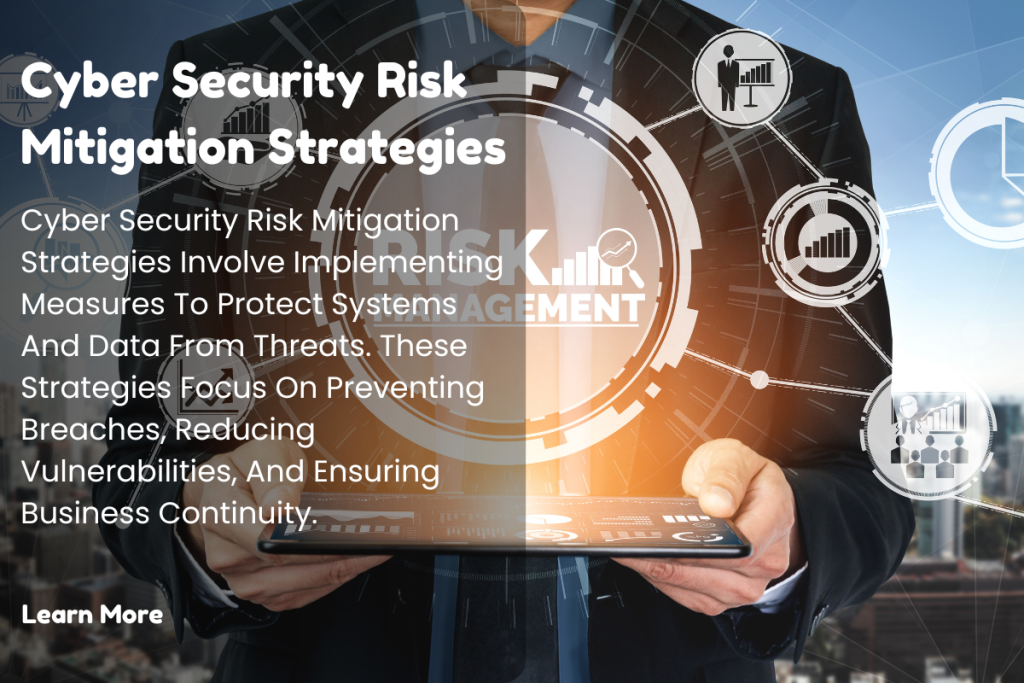
Understanding Cyber Security Risks And The Importance Of Mitigation Strategies
In today’s hyper-connected world, cyber security risks pose a significant challenge to individuals, businesses, and governments. With the increasing reliance on digital infrastructure and technology, malicious actors exploit vulnerabilities in systems, networks, and human behaviors. To protect valuable assets and ensure business continuity, organizations must understand the risks and implement robust mitigation strategies. This section provides an overview of cyber security risks, their impact, and the need for proactive approaches to reduce potential threats.
What Are Cyber Security Risks?
Cyber security risks refer to threats that can compromise the confidentiality, integrity, or availability of digital systems and data. These risks can arise from external malicious actors, internal vulnerabilities, or unintentional human errors. The nature of cyber threats has evolved with advancements in technology, making them more sophisticated and challenging to combat.
Some of the most prevalent cyber security risks include:
- Malware: Malicious software, such as viruses, worms, and Trojans, that infiltrate systems to disrupt operations, steal data, or cause damage.
- Phishing: Fraudulent emails or messages designed to deceive recipients into disclosing sensitive information, such as login credentials or financial details.
- Ransomware: A type of malware that encrypts files or systems and demands payment (ransom) to restore access.
- Insider Threats: Risks posed by employees or associates who misuse their access privileges, either intentionally or accidentally, to compromise security.
- DDoS Attacks: Distributed denial-of-service attacks that overwhelm a system or network with excessive traffic, rendering it inaccessible.
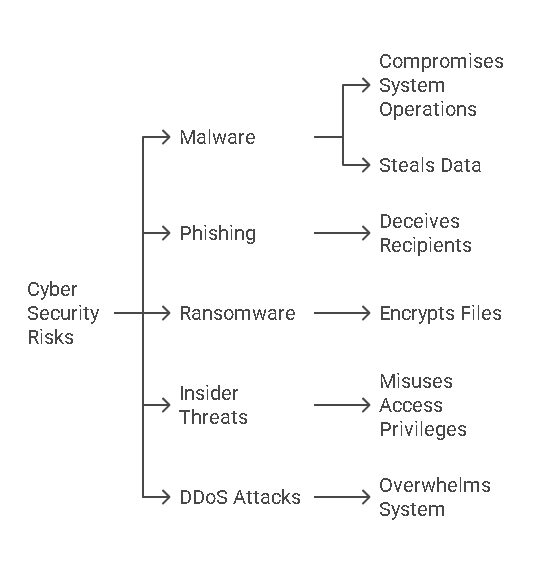
These threats target vulnerabilities in networks, applications, hardware, and human behavior. For example, outdated software, weak passwords, or a lack of employee awareness can create entry points for attackers.
The Impact Of Cyber Security Risks
The consequences of cyber threats are far-reaching and can affect organizations on multiple levels:
- Financial Losses: Cyber attacks often result in direct monetary losses due to theft, extortion, or business disruptions. For example, ransomware attacks force organizations to pay large sums to regain access to their systems.
- Data Breaches: Sensitive information, such as customer data, trade secrets, or intellectual property, can be exposed, leading to legal liabilities and regulatory fines.
- Reputation Damage: A successful cyber attack can erode trust among customers, partners, and stakeholders, causing long-term harm to an organization’s reputation.
- Operational Downtime: Cyber incidents can halt critical operations, leading to productivity losses and missed business opportunities.
- Legal And Regulatory Consequences: Failure to comply with data protection laws and standards may result in legal actions and financial penalties.
Industries such as finance, healthcare, government, and retail are particularly vulnerable due to the nature of the data they handle and their operational importance.
Why Is Cyber Security Risk Mitigation Important?
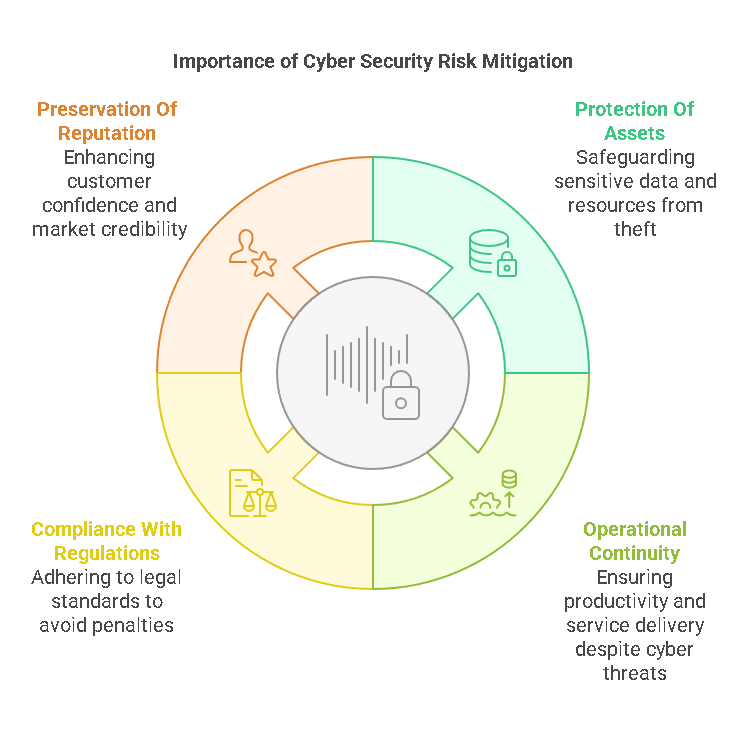
Risk mitigation is crucial for reducing the likelihood and impact of cyber threats. With cyber attacks growing in scale and sophistication, organizations cannot afford to be complacent. Implementing effective mitigation strategies ensures:
- Protection Of Assets: Safeguarding sensitive data, financial resources, and intellectual property from unauthorized access or theft.
- Operational Continuity: Minimizing disruptions caused by cyber incidents to maintain productivity and service delivery.
- Compliance With Regulations: Adhering to legal and industry standards to avoid penalties and build trust with stakeholders.
- Preservation Of Reputation: Demonstrating a commitment to security enhances customer confidence and market credibility.
Common Types Of Cyber Threats
Understanding the various types of cyber threats is essential for identifying vulnerabilities and designing appropriate defenses. Here are some of the most common threats and their characteristics:
- Phishing: Cybercriminals use fake emails, messages, or websites to trick users into revealing sensitive information. These attacks often appear legitimate and target individuals’ trust.
- Ransomware: Attackers encrypt files or systems, making them inaccessible until a ransom is paid. Ransomware incidents have increased significantly in recent years, affecting businesses and governments alike.
- Malware: This includes various forms of malicious software that can infiltrate systems to steal data, spy on user activity, or cause disruptions. Examples include spyware, adware, and rootkits.
- DDoS Attacks: By overwhelming a target system with excessive traffic, attackers make it unavailable to legitimate users. This is often used to disrupt online services or cause reputational harm.
- Insider Threats: Employees or associates with access to sensitive information may intentionally or unintentionally compromise security. This can occur due to negligence, greed, or coercion.
Each threat has unique characteristics and poses different challenges, making it necessary for organizations to adopt a comprehensive approach to risk management.
Overview Of Risk Mitigation Strategies
Risk mitigation strategies aim to minimize the likelihood of cyber threats and reduce their impact if they occur. These strategies are essential for maintaining a secure environment and fostering resilience against emerging threats.
Key strategies include:
- Employee Training And Awareness: Human error is one of the leading causes of security breaches. Training employees to recognize phishing attempts, use strong passwords, and follow security protocols is a fundamental step.
- Network Monitoring And Intrusion Detection: Regular monitoring of network activity helps detect anomalies and respond to threats before they escalate. Advanced tools like intrusion detection systems (IDS) play a critical role in this process.
- Data Encryption: Encrypting sensitive data ensures that even if it is intercepted, it remains inaccessible to unauthorized users. This is particularly important for protecting customer information and proprietary data.
- Regular Updates And Patching: Outdated software often contains vulnerabilities that attackers exploit. Keeping systems updated with the latest patches reduces these risks significantly.
- Incident Response Planning: Preparing for potential incidents with a clear response plan ensures that organizations can act quickly and minimize damage during a cyber attack.
By adopting these high-level strategies, organizations can build a strong foundation for their cyber security defenses. These approaches not only protect against existing threats but also provide the flexibility to adapt to new challenges as they emerge.
This comprehensive understanding of cyber security risks sets the stage for exploring detailed mitigation strategies and best practices in the next section. By focusing on proactive measures, organizations can safeguard their digital assets, reduce vulnerabilities, and maintain trust in an increasingly complex cyber landscape.
Cyber Security Risk Mitigation Strategies and Best Practices
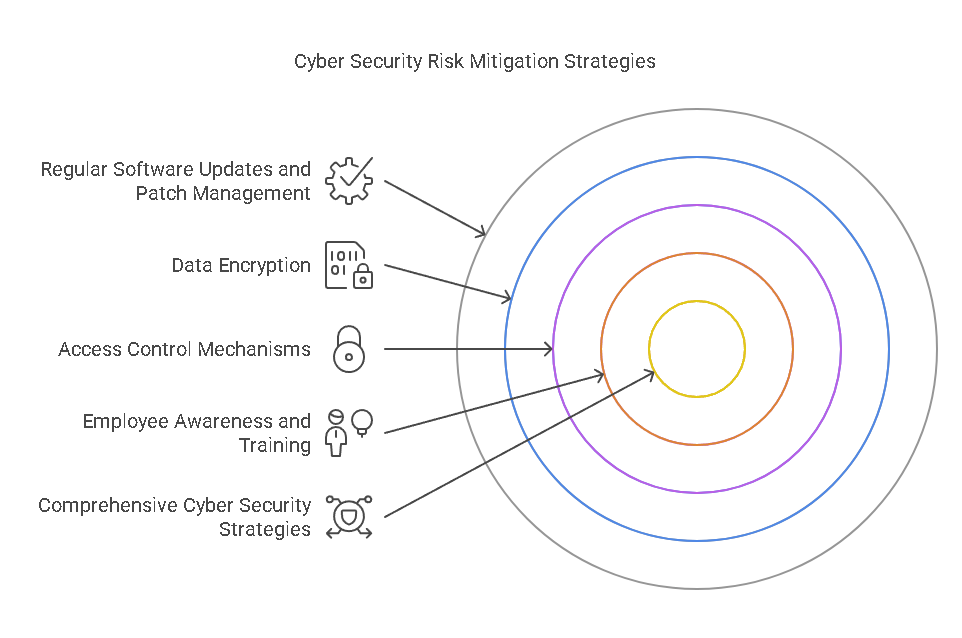
In an increasingly interconnected world, mitigating cyber security risks has become a strategic priority for organizations of all sizes. With sophisticated threats targeting vulnerable systems, it is essential to adopt a multifaceted approach combining robust strategies, advanced technologies, and tailored solutions. This section provides a deep dive into these strategies, explores the challenges of implementation, and highlights professional solutions for overcoming these barriers.
Comprehensive Cyber Security Strategies
Organizations must implement a suite of strategies to ensure comprehensive protection against cyber threats. These strategies target human, technical, and procedural vulnerabilities.
1. Employee Awareness and Training
Employees are often the weakest link in the security chain, making awareness and training pivotal.
- Training Programs: Conduct regular training sessions to educate employees about identifying phishing attempts, handling sensitive data, and recognizing signs of cyber attacks.
- Simulations: Use phishing simulation exercises to assess employee readiness and identify areas for improvement.
- Policies and Best Practices: Reinforce policies for secure password creation, device usage, and social engineering prevention.
For example, a manufacturing firm that introduced quarterly training programs reported a 45% drop in phishing-related incidents within six months.
2. Access Control Mechanisms
Restricting access to critical systems and sensitive data minimizes risks associated with insider threats and unauthorized access.
- Role-Based Access Control (RBAC): Assign permissions based on job roles, ensuring that employees access only what they need.
- Multi-Factor Authentication (MFA): Strengthen access security by requiring multiple forms of verification.
- The Principle of Least Privilege (POLP): Limit permissions to the minimum required for an employee’s tasks, reducing potential attack vectors.
An online retail company adopted MFA across its payment systems, reducing unauthorized access attempts by 60%.
3. Data Encryption
Encryption protects sensitive data from unauthorized access during transmission and storage.
- End-to-End Encryption: Commonly used for secure messaging, this ensures data remains protected throughout its journey.
- Data-at-Rest Encryption: Safeguards stored data, particularly in databases and cloud environments.
- Regulatory Compliance: Encryption helps organizations comply with data protection regulations like GDPR and HIPAA.
A financial institution encrypted its customer data to mitigate risks of breaches and comply with global privacy laws.
4. Regular Software Updates and Patch Management
Outdated software often contains exploitable vulnerabilities. To address this:
- Automated Updates: Schedule regular updates to ensure critical patches are applied promptly.
- Vendor Monitoring: Stay updated on security alerts and patches from software providers.
- Testing Protocols: Test patches in controlled environments before full implementation.
A tech startup implemented automated patch management, reducing successful exploitation attempts by 80%.
Advanced Technologies for Risk Mitigation
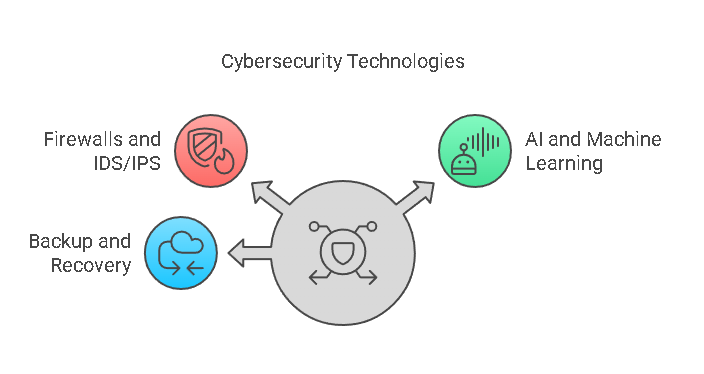
Technological advancements are instrumental in fortifying cyber defenses, offering both reactive and proactive protection.
1. Firewalls and Intrusion Detection Systems (IDS/IPS)
Firewalls and IDS/IPS play a crucial role in monitoring and blocking malicious activity.
- Next-Generation Firewalls: Incorporate application awareness and control, providing enhanced threat detection.
- Intrusion Detection Systems (IDS): Monitor network traffic for suspicious patterns.
- Intrusion Prevention Systems (IPS): Automatically block detected threats.
Large enterprises often deploy IDS/IPS solutions to prevent data exfiltration and detect unauthorized network activities.
2. Artificial Intelligence and Machine Learning
AI and machine learning are revolutionizing cyber security with advanced capabilities.
- Behavioral Analytics: Detect anomalies in user behavior, flagging potential threats.
- Threat Intelligence: Use AI to predict and prevent emerging attack patterns.
- Automated Response Systems: Mitigate threats in real time without human intervention.
For instance, a telecommunications company implemented AI-driven threat detection, cutting incident response times by 75%.
3. Backup and Recovery Solutions
Backup solutions ensure business continuity by enabling rapid recovery after a cyber attack.
- Cloud Backups: Offer secure, scalable, and redundant storage for critical data.
- Disaster Recovery Plans (DRP): Include comprehensive steps to restore systems and operations.
- Ransomware Resilience: Secure backups allow organizations to recover without paying ransoms.
A retail chain performed biannual DRP simulations, reducing recovery times by 50% in real scenarios.
Challenges in Implementing Cyber Security Strategies
Despite the availability of robust solutions, organizations face several hurdles in implementing effective cyber security measures:
- Budget Constraints: Small and medium-sized businesses often struggle to allocate funds for advanced tools and skilled personnel.
- Evolving Threat Landscape: New threats emerge regularly, making it challenging to stay ahead.
- Shortage of Skilled Professionals: There is a global shortage of trained cyber security experts.
- Integration Issues: Implementing new technologies without disrupting existing workflows is often complex.
These challenges necessitate external support from professional services like Precisehire, which offers customized cyber security solutions tailored to specific industry needs.
Cyber Security Strategy Comparison Table
The table below compares key cyber security strategies, highlighting their benefits and examples:
| Strategy | Benefit | Example |
|---|---|---|
| Employee Training | Reduces human error | Phishing simulation exercises |
| Access Control (RBAC) | Minimizes unauthorized access | Restricting financial data access to CFOs |
| Data Encryption | Protects sensitive information | End-to-end encrypted messaging systems |
| Software Updates | Patches vulnerabilities | Automated patch management for servers |
| AI and Machine Learning | Enhances threat detection | Behavioral analytics for anomaly detection |
| Backup Solutions | Ensures business continuity | Cloud-based backups for disaster recovery |
Tailored Solutions for Comprehensive Protection
To navigate the complexities of cyber security, organizations can rely on external expertise. Precisehire offers professional services, including:
- Comprehensive risk assessments to identify vulnerabilities.
- Implementation of advanced tools and techniques for enhanced protection.
- Ongoing monitoring and support to ensure compliance with regulatory standards.
Partnering with experts like Precisehire enables organizations to build a resilient security posture while overcoming resource and expertise limitations.
Legal Aspects, FAQs, and Conclusion
The ever-evolving landscape of cyber threats has made it crucial for organizations to not only adopt mitigation strategies but also ensure compliance with legal standards. This section explores the legal aspects of cyber security, answers frequently asked questions, and summarizes the importance of proactive risk mitigation in today’s digital age.
Legal Considerations in Cyber Security Risk Mitigation
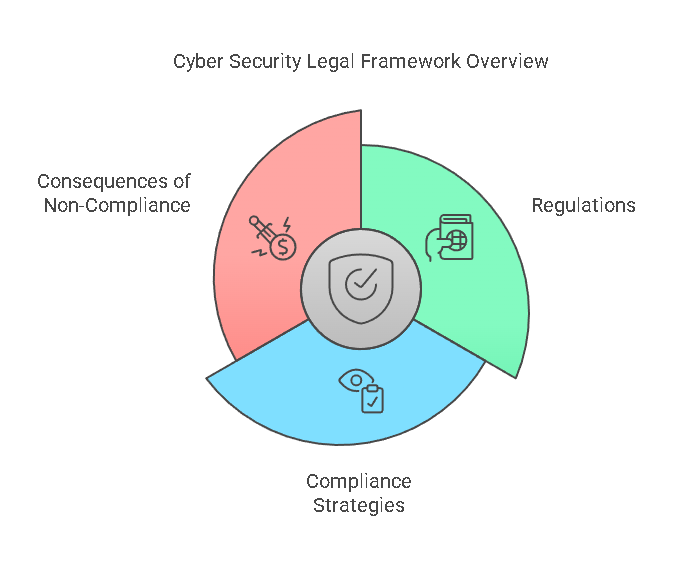
Cyber security laws and regulations are designed to protect sensitive data, uphold privacy, and minimize the impact of breaches. Organizations must adhere to these legal frameworks to avoid penalties and reputational damage.
1. Regulations Governing Cyber Security
Several global and regional regulations dictate how organizations handle data and address cyber risks:
- General Data Protection Regulation (GDPR): Applies to entities handling the personal data of EU citizens, emphasizing data protection, breach notification, and user consent.
- California Consumer Privacy Act (CCPA): Grants California residents rights over their personal data and mandates businesses to secure it effectively.
- Health Insurance Portability and Accountability Act (HIPAA): Requires healthcare organizations to protect sensitive patient information.
- ISO 27001: A global standard providing a framework for establishing and maintaining effective information security management systems (ISMS).
Non-compliance with these regulations can result in severe fines, legal action, and reputational harm. For instance, GDPR violations can incur fines of up to €20 million or 4% of annual global revenue, whichever is higher.
2. Ensuring Legal Compliance
To stay compliant, organizations must:
- Develop Comprehensive Policies: Create internal policies aligned with applicable regulations.
- Conduct Regular Audits: Perform routine assessments to identify and address gaps in compliance.
- Obtain Employee and Customer Consent: Ensure transparency by obtaining explicit consent before collecting or processing personal data.
- Engage Cyber Security Experts: Collaborate with services like Precisehire to conduct risk assessments and implement compliance-focused solutions.
3. Consequences of Non-Compliance
Failing to comply with cyber security laws can lead to:
- Financial Penalties: Organizations face hefty fines for breaches or mishandling data.
- Legal Action: Victims of data breaches may pursue lawsuits, resulting in additional costs.
- Reputation Damage: Publicized violations can erode customer trust and loyalty.
Frequently Asked Questions
What Is the Most Effective Way to Mitigate Cyber Security Risks?
The most effective approach involves a combination of strategies, including:
- Training employees to recognize and respond to threats.
- Implementing robust access controls and encryption protocols.
- Regularly updating software and conducting security audits.
How Often Should Organizations Update Their Cyber Security Measures?
Organizations should:
- Perform Quarterly Assessments: Regular reviews ensure defenses remain effective against emerging threats.
- Update Software Immediately: Apply patches as soon as they are released by vendors.
Are Small Businesses Equally Vulnerable to Cyber Threats?
Yes, small businesses are frequent targets due to limited resources and less sophisticated defenses. Investing in basic protections like firewalls, backups, and training is essential.
What Role Does Cyber Insurance Play in Risk Mitigation?
Cyber insurance helps organizations recover from financial losses associated with cyber attacks, such as data breaches and ransomware incidents. Policies often cover legal fees, recovery costs, and fines.
How Can Organizations Ensure Compliance With Cyber Security Laws?
To ensure compliance:
- Understand Applicable Regulations: Identify and adhere to relevant laws like GDPR and CCPA.
- Perform Regular Audits: Assess and improve compliance measures.
- Collaborate With Experts: Seek guidance from professional services like Precisehire to address compliance gaps.
Conclusion
Cyber security risk mitigation strategies are essential for protecting sensitive data, maintaining business continuity, and ensuring legal compliance. From training employees to leveraging advanced technologies, organizations must adopt a layered approach to counter cyber threats effectively.
Staying ahead of evolving cyber risks requires vigilance and expertise. Collaborating with professional services like Precisehire allows organizations to navigate the complexities of cyber security with confidence. By proactively addressing vulnerabilities and adhering to legal standards, businesses can safeguard their digital assets and build lasting trust with stakeholders.
